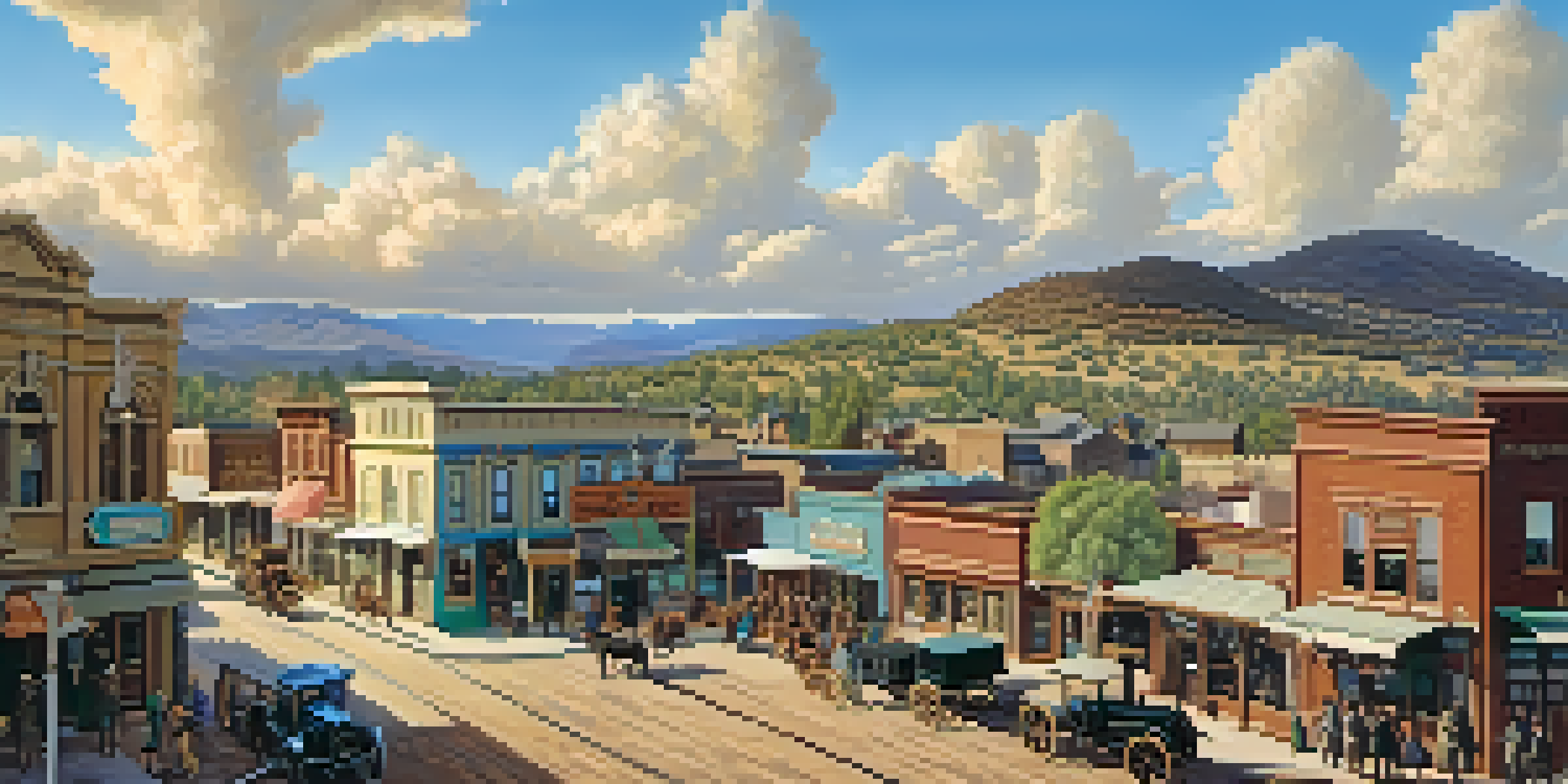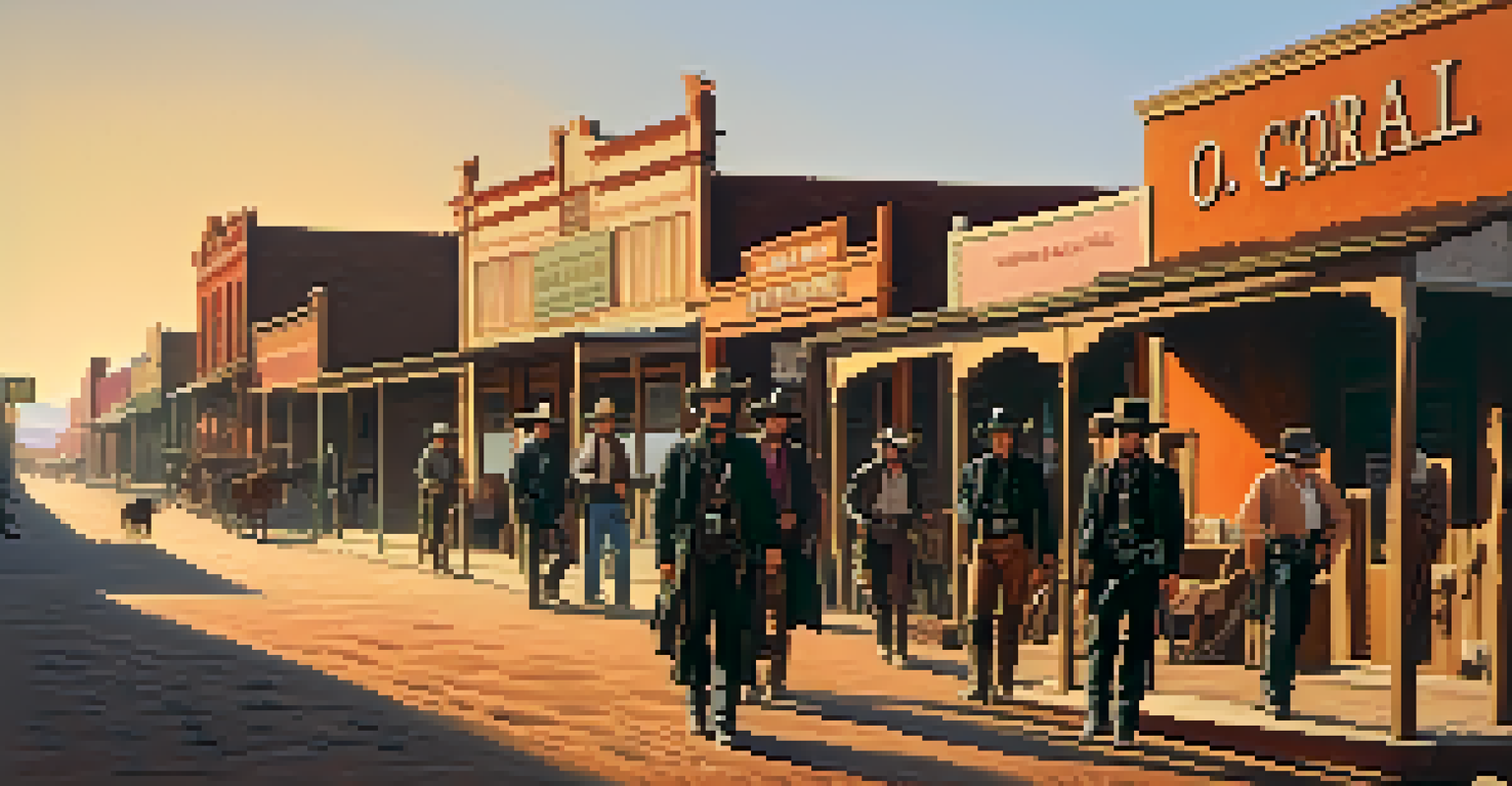Famous Mining Towns in Arizona: A Historical Overview

The Rise of Mining Towns in Arizona's Gold Rush Era
In the mid-19th century, Arizona became a hotspot for miners seeking fortune during the gold rush. Towns like Prescott and Wickenburg sprang up almost overnight, filled with eager prospectors and hopeful settlers. The promise of gold and silver attracted thousands, transforming the barren landscape into bustling communities.
The best way to predict the future is to create it.
These mining towns were not just about gold; they offered a glimpse into the American Dream, where hard work could lead to unimaginable wealth. As miners dug into the earth, they laid the groundwork for vibrant communities, complete with saloons, general stores, and schools. Each town had its own unique culture and character, shaped by the dreams and struggles of its inhabitants.
However, the boom was not without its challenges. Towns often faced hardships, such as harsh weather and economic instability when resources dwindled. Yet, these difficulties only added to the rich tapestry of stories that define Arizona’s mining heritage.
Prescott: The First Territorial Capital and Mining Hub
Prescott, Arizona, holds a special place in mining history as the first territorial capital. Founded in 1864, its location was strategic for miners heading to the nearby gold fields. The town quickly evolved, attracting entrepreneurs, and soon it became a center for supplies and services for miners.

The mining boom transformed Prescott into a thriving community, with a mix of cultures and backgrounds. Historic buildings still stand today, telling stories of the past, including the iconic Whiskey Row, famous for its saloons that welcomed weary miners. Walking through Prescott, you can almost hear the echoes of the past and feel the energy of the gold rush days.
Mining Towns Shaped Arizona's Identity
The rise of mining towns in Arizona during the gold rush era transformed the state's landscape and culture, creating vibrant communities fueled by the dreams of prospectors.
Though the gold eventually ran out, Prescott adapted and flourished, evolving into a cultural hub with art galleries and festivals that celebrate its rich history. Today, it stands as a testament to the resilience of mining towns and their ability to reinvent themselves.
Tombstone: The Legendary Town of the O.K. Corral
Tombstone is perhaps one of the most famous mining towns, known for its Wild West history and the iconic gunfight at the O.K. Corral. Founded in 1879, it quickly became a silver mining hotspot, attracting many fortune seekers. The town's motto, 'The Town Too Tough to Die,' reflects its storied past and the fierce spirit of its residents.
Success usually comes to those who are too busy to be looking for it.
During its peak, Tombstone boasted a thriving population and a bustling economy, complete with theaters, shops, and saloons. The town was a melting pot of different cultures, each contributing to its unique character. Today, it draws visitors who are eager to experience the Old West and witness the preserved historic sites.
Despite facing economic decline after the silver boom, Tombstone has managed to maintain its charm and historical significance. Tourists flock to reenactments of the famous gunfight, bringing the vibrant history of the Wild West alive for new generations.
Bisbee: A Mining Town with a Bohemian Twist
Nestled in the Mule Mountains, Bisbee offers a unique blend of mining history and artistic flair. Founded in 1880, it became a significant copper mining town, drawing thousands for its lucrative opportunities. The town’s picturesque setting and vibrant character have made it a haven for artists and creatives over the years.
Bisbee’s historic district is filled with colorful buildings and charming boutiques that reflect its eclectic spirit. The town hosts various art events and festivals, showcasing local talent and fostering a strong community. Many former miners and their families have become part of Bisbee’s rich tapestry, contributing to its artistic renaissance.
Towns Adapted Beyond Mining
As mining resources dwindled, towns like Prescott and Bisbee successfully reinvented themselves, becoming cultural hubs that celebrate their rich histories through art and tourism.
Even as mining operations ceased, Bisbee transformed into a popular tourist destination. Visitors can explore the famous Copper Queen Mine, delve into the town’s mining past, and enjoy the stunning views that make Bisbee truly one-of-a-kind.
Jerome: The Ghost Town with a Rich History
Jerome, once a booming copper mining town, now stands as a ghost town perched on the side of a mountain. Established in 1876, it became one of the largest mining towns in Arizona during its heyday. However, as mining declined, so did the town, leading to its eventual abandonment by many of its residents.
Despite its ghost town status, Jerome has experienced a resurgence as an artistic community and tourist attraction. The historic buildings, many of which have been restored, offer a glimpse into its vibrant past. Visitors can wander the streets, visiting art galleries, museums, and shops that celebrate the town's rich heritage.
Jerome's haunting beauty and intriguing history make it a must-visit destination for those interested in Arizona's mining legacy. The stories of its rise and fall are a testament to the cyclical nature of mining towns, capturing the imagination of all who explore its remnants.
Wickenburg: A Blend of Mining and Ranching Culture
Wickenburg, founded in 1863, is a town that beautifully blends mining and ranching heritage. Originally established as a gold mining camp, it quickly evolved into a center for cattle ranching, showcasing the diverse opportunities in Arizona. The town's rich history is evident in its well-preserved buildings and welcoming atmosphere.
As miners settled and established roots, Wickenburg grew into a close-knit community. The famous Vulture Mine, located nearby, was a significant contributor to the local economy and drew many prospectors to the area. Today, the town celebrates its dual heritage with events that honor both its mining and ranching roots.
Legacy of Resilience and Community
The stories of Arizona's mining towns reflect a spirit of resilience and camaraderie, with their historical significance continuing to inspire both residents and visitors today.
Visitors can explore the town's historic sites, including the old saloons and the Vulture Peak trail. Wickenburg's charm lies in its ability to blend the rugged spirit of the Old West with the warmth of a small-town community, making it a delightful stop for history enthusiasts.
Clifton and Morenci: The Copper Mining Giants
Clifton and Morenci are twin towns known for their rich copper mining history. Established in the late 19th century, they became crucial to Arizona's copper production, significantly impacting the local economy. The Morenci Mine, one of the largest copper mines in the world, played a pivotal role in the growth and development of both towns.
The towns' mining operations brought thousands of workers and their families, creating a vibrant, multicultural community. Clifton, with its historic charm, and Morenci, with its industrial prowess, showcase the duality of life in a mining region. Residents often share stories of hard work and camaraderie forged in the mines.

Though mining operations have changed over the years, Clifton and Morenci continue to honor their legacy. Community events, local museums, and preserved sites celebrate the towns' rich past, ensuring that the stories of their mining heritage live on.
The Legacy of Arizona's Mining Towns Today
The legacy of Arizona's mining towns continues to shape the state’s identity and culture today. Each town, with its unique story, contributes to the rich history of the American West. While mining may no longer dominate these communities, their historical significance remains a point of pride for residents and visitors alike.
Today, many of these towns have reinvented themselves, focusing on tourism and the arts. Historic buildings have been preserved, and festivals celebrate their mining heritage, bringing people together to share stories and experiences. The spirit of resilience that characterized these mining towns lives on.
Exploring Arizona's mining towns offers a fascinating glimpse into the past and highlights the importance of preserving history. As we learn from these stories, we understand the value of community, hard work, and the dreams that drive us all.